The light nor’-easter is still puffing away but as you spear off the main river and scoot your way up the narrow feeder creek, you’re greeted with kilometres of mangroves and glassy under-cut banks.
As you round each bend, the bankside vegetation begins to change. The thick, low-lying mangroves slowly give way to wispy-thin casuarinas perched high on precarious under-cut banks.
With the outboard shut down, all you can hear is the light breeze through the trees and the shrill of cicadas. You know you are in prime Summer bream country now.
As the weather gets hotter, so does the bream fishing.
But we're not talking about the deep, cold-water action at the river mouth a few months back. Now most of the bream have headed way upstream and the best places to go are those winding, tree-lined feeder creeks and tributaries up towards the brackish country.
This type of environment seems designed for lure anglers, especially those who love using surface lures.
The bream now in these small tributaries have learnt to be very opportunistic feeders, taking anything from tiny prawns, crabs and baby herring through to wayward cicadas and other insects struggling on the surface.
The Summer bream fishery is vastly different from the cool-water run at the river mouth.
Just like bass, up-river bream during the warmer months tend to spend a lot of their time looking up for food. Holding station around fallen timber, most bream will be milling around just waiting for something to sweep past.
A small minnow lure cast tight to cover, or a well-placed stickbait or popper will seldom be refused.
I just love working lures in these smaller systems and with a little forethought and a few creative ideas; you can have a ball fooling the fish.
Often you'll be greeted by plenty of fallen timber and in some places, getting a cast super-tight the woodwork can be challenging.
A good method in tidal waters to get the lure nice and close is to simply cast up-current and tight to the bank.
Wait a few seconds and the lure will drift right into the snags. A few nervous twitches and bumps and you should see any bream shoot up for a look.
Same goes for heavy overhangs: Cast up-current and let the lure sweep deep under the foliage. Often it will be taken well before you get to add some rodwork.
Depending on the creek, it's often a good idea to cast on a slight angle up-current, rather than at right angles to the bank.
This does three things: It runs the lure closer to the bank for longer; the lure will often follow the natural angle on any fallen timber, and it will come in from an angle the fish expect to see food approach from.
While not essential for success, these few little tips can certainly help trick the local fish.
The ideal craft for creek fishing will depend on the system you’re working.
In smaller creeks, a kayak or canoe can be ideal. In the larger systems – where covering a quite a few kilometres will be the norm – a small boat or powered canoe will be very handy.
I fish quite a few different creeks for bream and have pretty well covered all my bases with a 4m tinny, an electric-powered kayak and an old sit-in ’yak I use for the shorter runs.
Whichever craft you choose, success is largely reliant on your ability to be stealthy. It's fun and practical getting to a place at high speed but once there you have to keep noise and movement right to a minimum.
Bream residing in these smaller waters are very aware of boat noise. Most creeks are super quiet and the resident bream become accustomed to very little surface noise and most will shut up shop if you noisily drop your paddle, clang the anchor or stomp around heavily in the boat.
Once in these smaller feeder systems, you really need to go into stealth mode to consistently score fish.
When the weather and water heat up and the bream are biting freely in the upper reaches, many keen anglers will use nothing but topwater lures.
The surface action can be terrific. You often have schools of bream slurping and nipping surface the lure as it staggers across the surface.
Seeing those lips poke through the surface and hear those slurps, and it's pretty hard to tie any other form of lure!
For me, the ideal surface lure for bream is a small (sub 70mm) hard stickbait.
There's a whole heap to choose from and all will work, although some may prove more effective on a given day.
Some to add to your already full lure box are the Stiffy Top Dog, Ecogear PX 45 and PX 55, Bassday Sugapen, Berkley Scum Dog and Pop Dog, Daiwa Lazy Gekkabijin, Megabass Dog-X and so on.
There are plenty out there, so take a look and try to pick models that will best suit the local prawn/baitfish supply in the area.
If the bream are a little slow on top (not usually the case, but it can happen), next lures to try are small minnows.
Again the list is endless but you can't go too wrong with the Stiffy Minnow, Shimano Minnow, Berkley Pup Dog, Frenzy Fire Stick and Ecogear MW 48, MW 62 and MW 72.
And don't forget the old-school swimmers like the Rebel Crickhopper and Crawdad.
A well-worked minnow can do wonders, often sparking up seemingly dormant fish holding on timber or along under-cut banks.
Remember to cast tight and work the lure nice and slow.
Most species have prime feeding times and bream are no different.
In non-tidal systems prime feeding times will usually be those magical few hours around dawn and dusk.
In tidal waters, the same rule often applies although the tidal stage can also have a large bearing on activity.
Often the prime bite is around mid-tide out.
In many mangrove-lined creeks, this is the time small prawns and baitfish are forced to leave the high edge of the bank and drop into the main system.
Bream and other species will often cruise up and down the drop-offs, waiting eagerly for the smorgasbord of tasty morsels to pour out.
Ideally for those fishing tidal creeks, the combination of ebbing tide and low light levels is pretty hard to beat.
While the bream on average may not be as large as those found in cool water near the mouth, the environment and their sheer tenacity well and truly compensate.
For me, the Summer bream fishery is all about having fun with lures – especially the surface models – and getting out and exploring all those lovely feeder creeks and tributaries.
Reads: 8498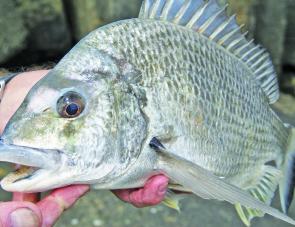
Some solid bream edge their way up-river during the warmer months. This one, and a few of its mates, had set up camp under a road bridge.
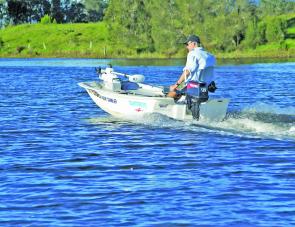
Summer is a great time to get out and about with the family. There are usually good numbers of bream around to keep the kids happy.
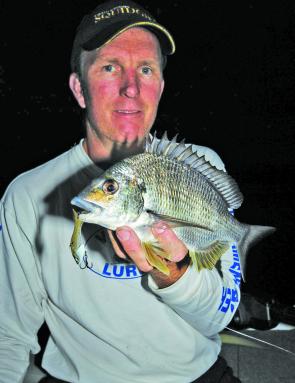
Jump in the boat and scoot up-river. You should find good numbers of bream in all the small feeder creeks and tributaries and you won’t need a go-fast bass boat to cover miles to get to them.

Bream are very nocturnal and will often bite freely at dusk and into the dark.
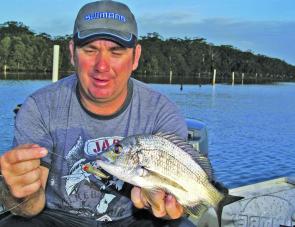
Surface lures work a treat on Summer bream. This one took a Viking lure worked around a shallow weed bed.

Poppers work wonders on bream. Fishing the oyster leases during the Summer is a winning tactic.
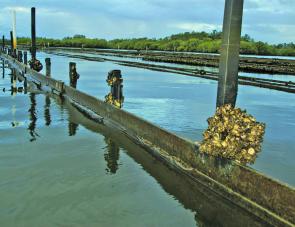
Prime Summer bream country: Head up-river and fish all those pretty side creeks and you should score good numbers.




